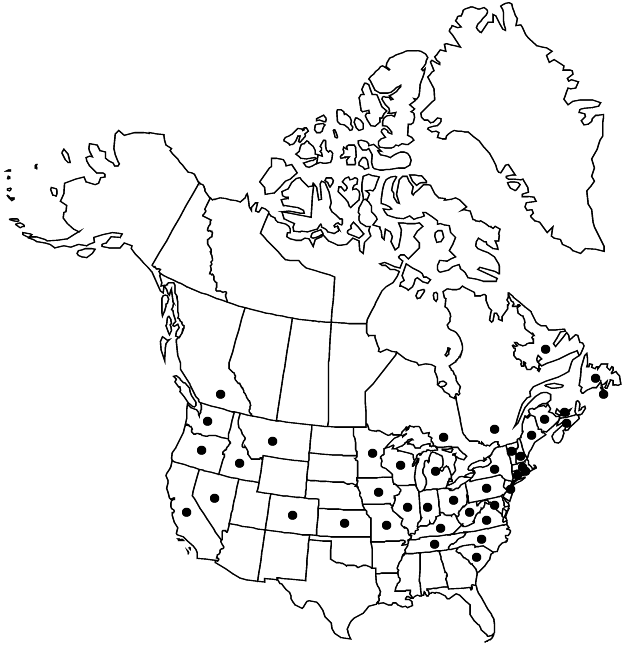Difference between revisions of "Stellaria graminea"
Sp. Pl. 1: 422. 1753.
FNA>Volume Importer |
imported>Volume Importer |
||
| (3 intermediate revisions by 2 users not shown) | |||
| Line 8: | Line 8: | ||
}} | }} | ||
|common_names=Common or grass-leaved stitchwort or starwort;mouron des champs | |common_names=Common or grass-leaved stitchwort or starwort;mouron des champs | ||
| + | |special_status={{Treatment/ID/Special_status | ||
| + | |code=W | ||
| + | |label=Weedy | ||
| + | }}{{Treatment/ID/Special_status | ||
| + | |code=I | ||
| + | |label=Introduced | ||
| + | }} | ||
|basionyms= | |basionyms= | ||
|synonyms={{Treatment/ID/Synonym | |synonyms={{Treatment/ID/Synonym | ||
|name=Alsine graminea | |name=Alsine graminea | ||
|authority=(Linnaeus) Britton | |authority=(Linnaeus) Britton | ||
| + | |rank=species | ||
}} | }} | ||
|hierarchy=Caryophyllaceae;Caryophyllaceae subfam. Alsinoideae;Stellaria;Stellaria graminea | |hierarchy=Caryophyllaceae;Caryophyllaceae subfam. Alsinoideae;Stellaria;Stellaria graminea | ||
| Line 27: | Line 35: | ||
|elevation=0-1200 m | |elevation=0-1200 m | ||
|distribution=St. Pierre and Miquelon;B.C.;N.B.;Nfld. and Labr.;N.S.;Ont.;P.E.I.;Que.;Calif.;Colo.;Conn.;D.C.;Idaho;Ill.;Ind.;Iowa;Kans.;Ky.;Maine;Mass.;Mich.;Minn.;Mo.;Mont.;Nev.;N.H.;N.J.;N.Y.;N.C.;Ohio;Oreg.;Pa.;R.I.;S.C.;Tenn.;Vt.;Va.;Wash.;W.Va.;Wis.;Europe. | |distribution=St. Pierre and Miquelon;B.C.;N.B.;Nfld. and Labr.;N.S.;Ont.;P.E.I.;Que.;Calif.;Colo.;Conn.;D.C.;Idaho;Ill.;Ind.;Iowa;Kans.;Ky.;Maine;Mass.;Mich.;Minn.;Mo.;Mont.;Nev.;N.H.;N.J.;N.Y.;N.C.;Ohio;Oreg.;Pa.;R.I.;S.C.;Tenn.;Vt.;Va.;Wash.;W.Va.;Wis.;Europe. | ||
| + | |introduced=true | ||
|discussion=<p>In Europe, both diploid and tetraploid cytotypes of <i>Stellaria graminea</i> occur with occasional triploid hybrids. Only the tetraploid form has been found in North America, except for a triploid colony in Newfoundland. This species is often confused with <i>S. longifolia</i> but differs in its stems, which are very angular, glabrous, and not scabrid; the narrowly triangular leaves on the flowering stems; the smooth leaf margins; the stiff, triangular, prominently 3-veined sepals; and the larger, rugulose seeds.</p><!-- | |discussion=<p>In Europe, both diploid and tetraploid cytotypes of <i>Stellaria graminea</i> occur with occasional triploid hybrids. Only the tetraploid form has been found in North America, except for a triploid colony in Newfoundland. This species is often confused with <i>S. longifolia</i> but differs in its stems, which are very angular, glabrous, and not scabrid; the narrowly triangular leaves on the flowering stems; the smooth leaf margins; the stiff, triangular, prominently 3-veined sepals; and the larger, rugulose seeds.</p><!-- | ||
| − | --><p>The sterile overwintering shoots of <i>Stellaria graminea</i> have broader elliptic to elliptic-lanceolate leaf blades measuring 5–15 × 1.5–4 mm. They are broadest near the middle. This state of the plant has been named < | + | --><p>The sterile overwintering shoots of <i>Stellaria graminea</i> have broader elliptic to elliptic-lanceolate leaf blades measuring 5–15 × 1.5–4 mm. They are broadest near the middle. This state of the plant has been named <i></i>var.<i> latifolia</i> Petermann. Usually <i>S. graminea</i> has perfect flowers but occasionally plants that are entirely staminate-sterile are encountered. The flowers in these are partially fertile depending on the occurrence of cross- pollination.</p> |
|tables= | |tables= | ||
|references= | |references= | ||
| Line 37: | Line 46: | ||
-->{{#Taxon: | -->{{#Taxon: | ||
name=Stellaria graminea | name=Stellaria graminea | ||
| − | |||
|authority=Linnaeus | |authority=Linnaeus | ||
|rank=species | |rank=species | ||
| Line 52: | Line 60: | ||
|publication title=Sp. Pl. | |publication title=Sp. Pl. | ||
|publication year=1753 | |publication year=1753 | ||
| − | |special status= | + | |special status=Weedy;Introduced |
| − | |source xml=https:// | + | |source xml=https://bitbucket.org/aafc-mbb/fna-data-curation/src/2e0870ddd59836b60bcf96646a41e87ea5a5943a/coarse_grained_fna_xml/V5/V5_218.xml |
|subfamily=Caryophyllaceae subfam. Alsinoideae | |subfamily=Caryophyllaceae subfam. Alsinoideae | ||
|genus=Stellaria | |genus=Stellaria | ||
Latest revision as of 22:09, 5 November 2020
Plants perennial, coarse, rhizomatous; rhizomes slender, elongate. Stems decumbent or ascending, straggling, diffusely branched, smoothly 4-angled, 20–90 cm, brittle, glabrous. Leaves sessile; blade linear-lanceolate to narrowly lanceolate, widest near base, 1.5–4 cm × 1–6 mm, base round, margins smooth, apex acute, often ciliate near base, otherwise glabrous, not glaucous. Inflorescences terminal, 5–many-flowered, open, conspicuously branched cymes; bracts narrowly lanceolate, 1–5 mm, wholly scarious, margins ciliate, apex acuminate. Pedicels divaricate, 10–30 mm, glabrous. Flowers 5–12 mm diam., rarely larger; sepals 5, distinctly 3-veined, narrowly lanceolate to triangular, 3–7 mm, margins narrow, straight, scarious, apex acute, glabrous; petals 5, 3–7 mm, equaling or longer than sepals; stamens 10, all, some, or none fully developed and fertile; styles 3, ascending, ca. 3 mm. Capsules green or straw colored, narrowly ovoid, 5–7 mm, longer than sepals, apex acute, opening by 3 valves, splitting into 6; carpophore absent. Seeds reddish brown, reniform-rotund, ca. 1 mm diam., rugose in concentric rings. 2n = 39, 52.
Phenology: Flowering late spring–early summer.
Habitat: Rough grasslands, pastures, hayfields, roadsides
Elevation: 0-1200 m
Distribution

Introduced; St. Pierre and Miquelon, B.C., N.B., Nfld. and Labr., N.S., Ont., P.E.I., Que., Calif., Colo., Conn., D.C., Idaho, Ill., Ind., Iowa, Kans., Ky., Maine, Mass., Mich., Minn., Mo., Mont., Nev., N.H., N.J., N.Y., N.C., Ohio, Oreg., Pa., R.I., S.C., Tenn., Vt., Va., Wash., W.Va., Wis., Europe.
Discussion
In Europe, both diploid and tetraploid cytotypes of Stellaria graminea occur with occasional triploid hybrids. Only the tetraploid form has been found in North America, except for a triploid colony in Newfoundland. This species is often confused with S. longifolia but differs in its stems, which are very angular, glabrous, and not scabrid; the narrowly triangular leaves on the flowering stems; the smooth leaf margins; the stiff, triangular, prominently 3-veined sepals; and the larger, rugulose seeds.
The sterile overwintering shoots of Stellaria graminea have broader elliptic to elliptic-lanceolate leaf blades measuring 5–15 × 1.5–4 mm. They are broadest near the middle. This state of the plant has been named var. latifolia Petermann. Usually S. graminea has perfect flowers but occasionally plants that are entirely staminate-sterile are encountered. The flowers in these are partially fertile depending on the occurrence of cross- pollination.
Selected References
None.